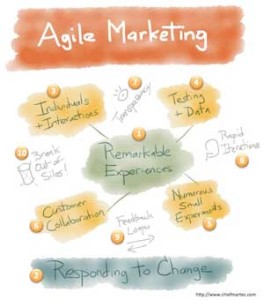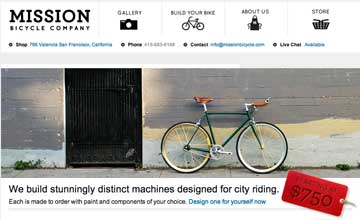
Last night, at the Seattle Agile Marketing Meetup, Scott Brinker of Chief Marketing Technologist joined us. Scott walked us through his diagram of Agile Marketing (shown at left and described in his blog) – in particular, his explanation of the centrality of creating great customer experiences resonated with me and deepened my understanding of our tasks as Agile Marketers.
As best I can remember, Scott said something like the following:
Just as it was the stated goal of the agile developers who gathered in Snowbird, Utah in 2001 to create a better way of building great working software, the goal of agile marketers should be to create a better way of building great customer experiences.
As is made clear in the diagram (and in Scott’s commentary), great customer experiences are core to everything we do as agile marketers.
Which leads me to the next question: what constitutes a great customer experience?
Meet Customer Needs, Stated and Un-Stated
A great customer experience, whether we deliver it through our websites, landing pages, content marketing, in-person presentations, or advertisements, meets the customer needs, stated and un-stated. As marketers, we are often satisfying their needs not through the product or service itself, but through the buying process. When a customer encounters our website for the first time, do they find what they need, both what they came for, and perhaps, new information or new experiences that they didn’t know they needed until they experienced them? Do our advertisements meet our customers needs for education or entertainment in a way that respects their intelligence, and guides them towards a buying decision?
Agile Marketing can help us create great customer experiences that meet customer needs through the medium of User Stories. User stories are a way to document customer needs, and ensure that our marketing meets those customer needs.
Incorporate Great Design
Great customer experiences almost always involve great design. Of course Apple is the obvious exemplar of this. Not only do their products exhibit great design, but so does their marketing. Think of their original iPod commercials, with dancers in outline and the flowing white lines of their earbuds; that’s great design. Take a look at Apple’s web site compared to those of Dell or HP or Lenovo – design certainly stands out as one of the things that differentiates Apple’s web site.
 But it’s not just Apple. Take a look at the website from Mission Bicycle at left. This is a great customer experience for a number of reasons, but one of the foremost reasons is the clean and attractive design.
But it’s not just Apple. Take a look at the website from Mission Bicycle at left. This is a great customer experience for a number of reasons, but one of the foremost reasons is the clean and attractive design.
Agile Marketing can help us incorporate great design in to great customer experiences by encouraging us to break down silos and collaborate both with our own internal design team and our customers. Great design is almost always the result of many iterations, and Agile Marketing encourages us to iterate, improving our design (and the customer experience).
Pay Incredible Attention to Detail
Great customer experiences result from incredible, almost fanatical attention to detail. Not only is the experience free from “bugs”, but it also introduces small details that deepen the experience and delight us. Of course, Steve Jobs and his obsessive attention to detail come to mind. But other companies also deliver on incredible attention to detail in their marketing.
 If you watched the track and field portion of the London 2012 Olympic games, you saw the Nike shoe at the left. It was worn by athletes like USA’s Ashton Eaton and Trey Hardee, Great Britain’s Mo Farah and France’s Renaud Lavillenie, and over 400 others. The distinctive sight of those neon green shoes on the television screen couldn’t be missed. Nike got tons of free publicity, even though they weren’t an official sponsor of the games (that was Adidas).
If you watched the track and field portion of the London 2012 Olympic games, you saw the Nike shoe at the left. It was worn by athletes like USA’s Ashton Eaton and Trey Hardee, Great Britain’s Mo Farah and France’s Renaud Lavillenie, and over 400 others. The distinctive sight of those neon green shoes on the television screen couldn’t be missed. Nike got tons of free publicity, even though they weren’t an official sponsor of the games (that was Adidas).
This didn’t happen by accident. As described in this cover story in Advertising Age, Nike spent almost four years testing this shoe and this color for the Olympic games. They held focus groups with hundreds of athletes, they tested how the shoe looked against the background of the various tracks, the grass, and the other environments where they would be seen. They measured, scientifically, and found out that this color, which they call Volt, is the most visible color to the human eye.
How can Agile Marketing help us create great customer experiences with incredible attention to detail? Primarily through measurement and testing, but also through a focus on the customer. Paying millions of dollars to be the official sponsor of the Olympic games does little to benefit the athletes directly. Nike chose to spend their money on creating something great for the athletes, and also for the audience watching, through incredible attention to detail.


Have you ever read the book “The Leader’s Guide to Radical Management?” In it, the author outlines his seven principles for continuous innovation, and the first is “Delighting Clients.”
I find it interesting that as you, Scott and others have been establishing the idea of Agile Marketing, others have been independently looking at what has made Agile Development successful and how to apply it to non-development disciplines, and that everyone seems to identify the same set of driving principles.
Jamie,
I haven’t read that book. I’ll look for it. I do think that the rise in the power of the customer is pushing us all in the same direction.
Jim
Have you ever read the book “The Leader’s Guide to Radical Management?” In it, the author outlines his seven principles for continuous innovation, and the first is “Delighting Clients.”
I find it interesting that as you, Scott and others have been establishing the idea of Agile Marketing, others have been independently looking at what has made Agile Development successful and how to apply it to non-development disciplines, and that everyone seems to identify the same set of driving principles.
Jamie,
I haven’t read that book. I’ll look for it. I do think that the rise in the power of the customer is pushing us all in the same direction.
Jim
Hi Jim, I’ve always thought that what we do as “marketers” enables customers to talk with the right person at the right time to answer questions. All of what we do, as you describe, is build a path to that end or beginning. What do you think?
Hi Jim, I’ve always thought that what we do as “marketers” enables customers to talk with the right person at the right time to answer questions. All of what we do, as you describe, is build a path to that end or beginning. What do you think?
Karol, yeah, I agree. I like to think of the most helpful salesperson I’ve ever encountered: they answer your questions, point out things that you might have missed, and generally help you make the best decision you can make.
Karol, yeah, I agree. I like to think of the most helpful salesperson I’ve ever encountered: they answer your questions, point out things that you might have missed, and generally help you make the best decision you can make.
I agree. Now, most marketers are now using Agile practices for planning their marketing activities. They create work plans and prioritize them as a team on a weekly basis. That ways they can ensure the majority of their work is focused against their marketing goals or targets.
I agree. Now, most marketers are now using Agile practices for planning their marketing activities. They create work plans and prioritize them as a team on a weekly basis. That ways they can ensure the majority of their work is focused against their marketing goals or targets.